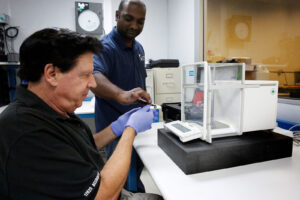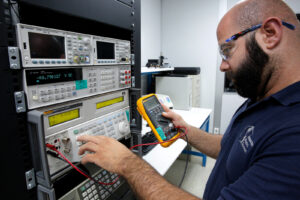Accurate flow measurement plays a critical role in industries ranging from oil and gas to pharmaceutical manufacturing, water treatment, and chemical processing. The ongoing debate between ultrasonic and traditional flow measurement methods often centers around precision, efficiency, reliability, and cost-effectiveness. As calibration experts, we understand the intricacies of both technologies. In this article, we offer an in-depth comparison between ultrasonic and traditional flow measurement systems, with a particular emphasis on calibration practices.
Understanding Ultrasonic Flow Measurement
Ultrasonic flow meters rely on sound waves to calculate the velocity of a fluid. There are two main types:
- Transit-Time Ultrasonic Flow Meters: Measure the time difference between signals sent upstream and downstream.
- Doppler Ultrasonic Flow Meters: Use frequency shifts caused by particles or bubbles in the flow stream.
These devices are non-invasive, often clamp-on, and ideal for applications where maintenance access is limited or process disruption is not an option.
Overview of Traditional Flow Measurement Methods
Traditional flow meters include:
- Turbine Meters
- Positive Displacement Meters
- Electromagnetic Meters
- Coriolis and Differential Pressure (DP) Meters
These systems typically involve intrusive installations and direct contact with the fluid. While proven in legacy systems, traditional meters often require more frequent calibration and maintenance.
Accuracy and Precision: Ultrasonic vs. Traditional
When evaluating any flow meter calibration method, accuracy and repeatability are paramount.
- Ultrasonic meters offer excellent repeatability, with modern models achieving ±0.5% accuracy for clean liquids and ±1% for gas applications.
- Traditional meters, depending on type, can range from ±0.1% to ±2%, though performance may degrade due to wear and tear, especially in mechanical systems.
Calibration of ultrasonic meters is often more stable over time due to the lack of moving parts, while mechanical meters may drift and require more frequent recalibration.
Maintenance and Downtime Implications
The non-intrusive nature of ultrasonic meters means zero process interruption during installation or calibration. Most modern ultrasonic systems support in-situ calibration, significantly reducing downtime and labor costs.
By contrast, traditional flow meters often require:
- System shutdowns
- Bypass setups
- Removal from pipelines
- Cleaning and part replacements
In industries where uptime is critical, such as refining or semiconductor manufacturing, ultrasonic meters provide a clear advantage.
Cost Comparison Over the Equipment Lifecycle
Initial costs for ultrasonic flow meters may be higher, particularly for high-end transit-time systems. However, when we consider the total cost of ownership (TCO)—including maintenance, recalibration, and downtime costs—ultrasonic meters frequently offer a better return on investment (ROI).
Traditional meters, while often cheaper up front, incur hidden costs:
- Periodic recalibration service
- Replacement of worn components
- Process interruptions
For long-term, continuous processes, ultrasonic flow meters often outperform traditional systems economically.
Calibration Methods for Ultrasonic Flow Meters
Calibration of ultrasonic meters is typically performed in three ways:
- Flow Proving (Gravimetric or Volumetric)
- Comparison Against a Master Meter
- Simulated Signal Verification
Ultrasonic devices often support built-in diagnostics, making it easier to detect drift, sensor fouling, or air entrapment. These features reduce the need for frequent manual recalibration, especially in clean service environments.
Calibration Methods for Traditional Flow Meters
Traditional meters require more complex calibration protocols:
- Turbine and Positive Displacement Meters must be tested against NIST-traceable standards in controlled lab conditions.
- Electromagnetic and Coriolis Meters require zero-point adjustment and linearity checks.
- Differential Pressure Meters involve multiple variable calibrations (e.g., orifice plates, transmitters, and impulse lines).
Traditional meter calibration often demands full disassembly and may require sending equipment to off-site calibration labs, increasing turnaround time.
Application Suitability
Ultrasonic Flow Meters excel in:
- Large pipe diameters
- Corrosive or abrasive fluids
- Bi-directional flow
- Temporary or mobile installations
- Clean water, wastewater, and HVAC applications
Traditional Flow Meters remain effective in:
- Custody transfer of oil and gas
- Low-viscosity fluids with steady flow
- High-pressure systems
- Applications requiring ultra-high precision
For example, Coriolis meters still outperform all others in mass flow accuracy, making them a preferred option in pharmaceutical and chemical batching processes.
Data Integration and Smart Calibration Features
Modern ultrasonic meters support advanced features:
- Digital protocols (MODBUS, HART, Ethernet)
- Remote diagnostics and alerts
- Self-check routines
- Predictive maintenance scheduling
Traditional meters are often less integrated with automation systems unless retrofitted with smart transmitters.
Environmental and Safety Considerations
Ultrasonic systems offer superior safety profiles:
- No pressure drop
- No intrusion or exposure to hazardous fluids
- Fewer potential leak points
Traditional meters increase risks during calibration or maintenance, especially in flammable or toxic environments.
Industry Standards and Regulatory Compliance
Both technologies are supported by international calibration standards, including:
- ISO 17025
- API MPMS
- AWWA M22 for ultrasonic meters
- ASME MFC series
Calibration labs must ensure traceability to national metrology institutes and comply with industry-specific regulations, such as FDA CFR Part 11 in pharmaceutical manufacturing.
Choosing the Right Calibration Method
We recommend basing your choice on the following factors:
- Fluid type and cleanliness
- Required measurement precision
- Pipe size and flow range
- Budget and long-term cost expectations
- Access for maintenance and calibration
- Compliance and reporting requirements
Ultrasonic calibration methods offer unmatched advantages in flexibility, minimal disruption, and digital integration, while traditional methods retain their relevance in legacy systems and extreme accuracy environments.
Conclusion: The Future of Flow Calibration
As industries continue to evolve toward automation, predictive maintenance, and energy efficiency, the shift toward ultrasonic flow measurement and smart calibration is accelerating. While traditional flow meters have laid the foundation, their limitations are becoming increasingly evident in modern process demands.
By investing in ultrasonic flow meters with advanced calibration protocols, facilities can achieve better accuracy, efficiency, and cost savings, all while maintaining regulatory compliance and operational excellence.
Ultimately, the best calibration method depends on your specific needs—but for most applications, ultrasonic calibration methods offer a future-ready solution that outperforms the traditional approach.





